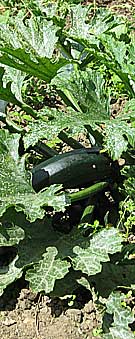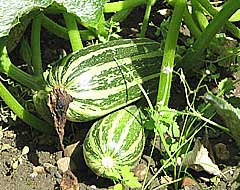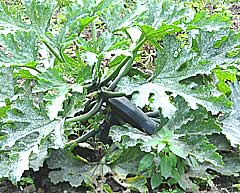How to grow and sow Marrows and Courgettes
VARIETIES OF MARROW AND COURGETTE
Bush Varieties
Long Green Bush, Long White Bush, Green Bush Improved, Prokor,
Golden Zucchini
Trailing Varieties of Marrow
Long White Trailing, Long Green Stripped, Table Dainty,
Moore's Cream,
Tasty Wonder,
Pen y Byd,
Rotherside Orange
Novelty Varieties of Marrow
Little Gem,
Sweet Dumpling, Custard Yellow, Custard White, Vegetable Spaghetti, Patty
Pan

CONTROLLING PESTS
You might have to syringe the leaves of marrow plants in hot weather to keep the red spider might at bay.
Slugs love to eat the young marrow plants so do all you can to keep them away.
STORING MARROWS
For storing in winter – set aside as many as required
for this purpose and allow marrows to grow to full size when fully ripe
and harvest at the end of the season in the autumn. These will keep right
through the winter under cool, dry conditions. 7C (45F) A good way is
to use netting and hang the marrows out of the way.
Never store marrows touching each other, or they may rot.
VEGETABLE PAGES
SOCIETIES

GROWING MARROWS AND COURGETTES
 Marrow
- Cucurbit a Pepo ovifera (fam. Cucurbitaceae)
Marrow
- Cucurbit a Pepo ovifera (fam. Cucurbitaceae)
The Vegetable Marrow or Courgette plant is a half hardy annual - vigorous trailing plant.
The marrow belongs to the family Cucurbitaceae.
The Pumpkin, Cucurbita Pepo, of which the Vegetable Marrow is a variety, is a native plant of the Near East
The marrow is an easy vegetable to grow - with care you can have a very large crop in a relatively short time.
Picked while young and tender the baby marrow known in France as the courgette and in Italy as zucchini make a very pleasant hot vegetable dish.
Marrows are climbing plants by nature.
COURGETTE VARIETIES OF MARROW
Although so-called courgette varieties of marrow are available, in fact the fruits of any marrow can be eaten small, and you can also eat the bright yellow flowers.
HARVESTING MARROWS AND COURGETTES
Sowing to harvest time: 12-14 weeks.
Size: courgettes best cut when 7.5-10cm(3-4”)long; Marrows best cut when 25cm (10”) long, but will grow to 1mtr (3`);
Yield: varies according to size cut—15-20 courgettes per plant; 5-6 marrows per plant, average weight of 1.5kg (3lb) each.
TIPS ON CULTIVATION OF MARROWS AND COURGETTES
 Full
grown marrows tend to lack flavour so harvest them before
they reach their maximum size.
Full
grown marrows tend to lack flavour so harvest them before
they reach their maximum size.
Sometimes a marrow plant will makes too luxuriant growth and does not bear fruits freely.
Commonly planted on heaps of decayed manure, garden refuse or turf, but it may be grown on the level ground or even on a trellis or arch.
In the latter position the flowers are well exposed to sunshine and air, and are therefore likely to bear fruits more freely than when the plants are grown on a mound of rich soil where the growth is so vigorous that the flowers are hidden among the large leaves.
PROBLEMS WITH MARROWS - NO FRUITS FORMING!
Failure of the fruits to form - If the marrows or courgettes do not form, which is a common complaint ,especially in a dull, damp summer and you find the crop disappointing; this is mostly due to planting in too rich a soil or a somewhat too shady place, failure to fertilize the blooms, and to the flowers being smothered by the too luxuriant leafage.
It is best to thin out some of the shoots to expose the remainder to air and sunlight.
POLLINATION OF MARROW AND COURGETTE FLOWERS
If it is very cold, wet or windy while the plants are flowering then natural pollination is less likely to be successful. Hand pollination is the best method in these circumstances.
Marrows under glass should always be hand pollinated.
The female flowers are distinguished by the swelling below the bloom.
Male flowers have a prominent central core, bearing yellow pollen.
The male flower is first to appear and the female flowers will follow.
To hand pollinate, remove the petals from a male flower; push the core into the centre of the female flower.
For a high success rate, use a different male for each female flower.
WHEN TO SOW MARROW SEEDS
The time for sowing depends on where the marrows are going to grow.
If grown entirely in a heated greenhouse marrow seed can be sown in situ in late winter, or early spring for transplanting to a cloche or cold frame.
If you do not have any glass, then delay sowing marrow seed until late spring to avoid damage from heavy frost.
A minimum temperature of 10c (50F) will be needed for germination, which can be supplied in the greenhouse, glazed porch, or cold frame.
Sow the seeds singly 1.2cm deep, in peat pots filled with seed compost. Sow the seeds on edge, not flat.
Germination should take place 10-14 days later. But if temperatures are higher you could expect sprouting in 4-6 days.
After germination the young plants will grow very quickly and will need re –potting almost at once.
PLANTING OUT MARROWS AND COURGETTES
Harden off and when ready they can be planted outdoors with protection towards the end of mid spring.
CARE OF VEGETABLE MARROW AND COURGETTE PLANTS
Do not let the plants dry out and at the same time do not over water. Hoe gently to keep the weeds down.
Avoid splashing water on the stems of the young marrow plants. You can apply a moist mulch about 1.2cm deep of grass cuttings or compost after watering. This helps conserve soil moisture and keeps the weeds down.
If roots appear above the surface of the soil, gently cover with 2.5cm of fine soil mixed with compost.
It is advisable to feed from time to time when watering with a liquid manure.
HARVESTING MARROWS
Pick marrows before the skin hardens; your finger nails should be able to pierce the skin easily.
Cut the marrows with a knife or secateurs - do not pull them off.
Harvesting the fruit when young encourages the plant to produce more fruit - since marrows tend to be heavy croppers and the baby ones have more flavour this seems to be a good policy.
Bushy Marrow Plants should be allowed to ripen as they are of poor flavour until mature.
GARDENING ARTICLES AND RESOURCES ON GARDEN GROWER
Expert advice on how to sow and grow the best Marrows and Courgettes in your vegetable garden with hints on harvesting and storing your marrows, problem solving and pest control